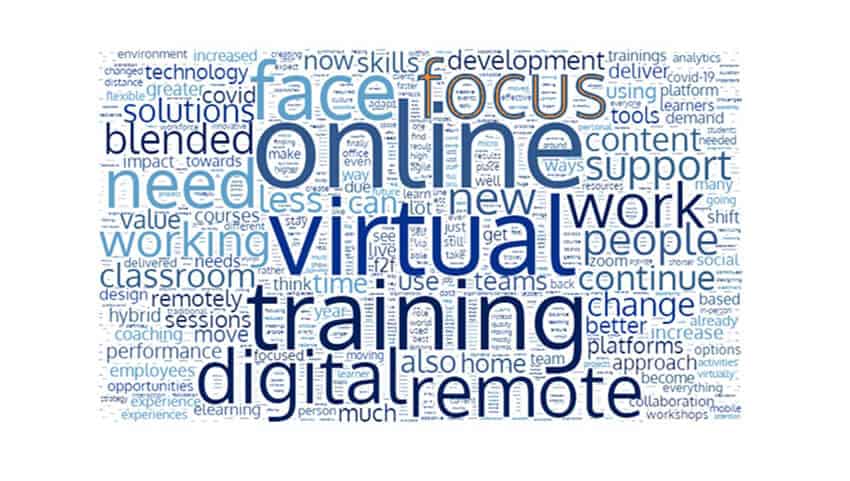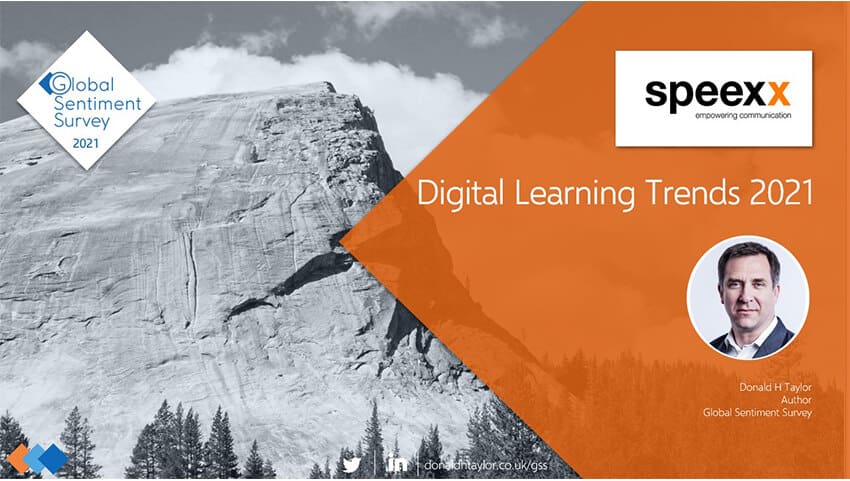
Why should you consider reprioritizing digital skills training in your learning and training strategy?
The answer lies in the data.
In February this year, Speexx held a Masterclass Webinar with Donald Taylor discussing and analyzing the results from his annual L&D Global Sentiment Survey.
Each year, the L&D Global Sentiment Survey checks in with the L&D community worldwide. The format consists of a short online poll asking L&D professionals of various positions what they think will be trending in the following year.
More specifically, the question asks: “What will be hot in workplace L&D?”
Improve communication skills for your entire workforce with digital language training – contact Speexx for more information
Enhancing digital skills training is the new normal
With eight years of aggregated data, the information provided from this report is nothing short of fascinating.
As one would imagine, this year’s results differ greatly from prior years – in no small part due to the pandemic. In the webinar, Donald delves deep into the results and explains what they mean for our “new normal” in work and learning.
As expected, the report provides insightful data with an interesting forecast into the future. However, this year was one like no other.
In this article, we will share the areas of focus for the future of L&D uncovered by the survey and why enhancing the digital skills and skillset of our workforce is the best approach for the future of L&D.
Back to basics for the learning community
“If there’s one thing that 2020 has taught us is that we have to be aware of what’s happening outside the organization, so that we can adjust ourselves and be ready for what’s happening next.” – Donald H. Taylor
To kick off Donald’s presentation, one obvious anomaly which needed to be acknowledged was the effect that COVID-19 had on the results of the report.
With this information in mind, you can understand that when looking at the results, something is quite different than from years before.
For the first time ever, reskilling and upskilling were identified as “what was hot in L&D this coming year”, subsequently pushing down all other hot topics such as collaborative and social learning, artificial intelligence and virtual and augmented reality.
As Donald and the webinar participants dissected the results of the report from each angle, it became evident that COVID-19 has changed the way L&D views what may be considered “hot” this year, and possibly for years to come.
What’s more, the report had unexpectedly uncovered a deeper concern within the L&D community, forcing us to reevaluate how digital skills and digital skills training programs should be prioritized in learning.
Digital skills training as a new priority
In the past few years, the L&D Global Sentiment Survey has taken a pulse check on the L&D community to discover what they think is “hot” and trending, allowing others to share and explore new innovative approaches to their learning strategy.
In short, what we’ve learned in the past years is that L&D, while sometimes hesitant to learning and training plans when it comes to making the switch from face-to-face to digital, had generally become interested in the idea of including more innovative technology into their learning programs to account for the growing demand for digital skills.
As we all know, integrating digital skills training practices into traditional learning programs to improve digital skillset was no longer going to be optional for those who wanted to keep L&D alive during the global pandemic.
Change in direction for L&D
As a result, the survey made certain to address this specific situation.
In the form of a free text answer, Donald asked,
“How will your learning and development work change as a result of COVID-19?”
Surprisingly, 44% of participants responded to this question with over 24,000 words to review. By using a word cloud, Donald was able to see which words dominated the space. By removing the words “learning” and “will”, the word cloud revealed a very interesting cluster of words highlighting the true direction in which L&D leaders believe their work will change as a result of COVID-19.
And you can see here in the above image, there is mention of:
- Online delivery
- Virtual learning and training
- Digital skills training
- Remote work
But there is another set of words which jumps out on the page. It is “focus”. Or rather, “focus on”.
What exactly will change with our focus in L&D going forward as a result of the global pandemic?
The future focus of L&D is all about digital skills training
It is inherently part of the job in learning and development to train people. But what is happening now is that there is more of it happening in both the formal and informal sense. This wave of demand is forcing us to rethink exactly how we want to reskill and upskill our workforce because in the end we people to have more digital skills.
Donald revealed three key areas of focus.
- Digital delivery channels – virtual learning and digital delivery
- Effective training
- Supporting the business, adding value and performance
In short, what this indicates is that a core of L&D practices will have a new focus on digital skills training in 2021.
And from this, we discovered that not only is our job to reskill and upskill our workforce, but the way we would do that is by training people on how to be digital first.
As Donald explains in the webinar, “What’s going to happen is by talking to people, by using the right technologies we have now we can build strategic influence, not just do our jobs better be strategically influential on solid foundations.”
Having basic digital skills is no longer going to be enough in the workplace of the future. Our workforce is depending on us to provide them with the support they need to stay sharp and productive with advanced digital literacy.
To find out more about corporate training trends and how to successfully move your traditional training to digital, be sure to get in touch with our digital transformation experts here at Speexx.
Strategic L&D will prioritize digital skills training
Indeed, the Global Sentiment Survey 2021 did confirm that a majority of L&D professionals are concerning themselves with reskilling and upskilling their workforce now more than ever.
But the reason for this is that L&D leaders are aiming to have a more strategic approach, or focus, in their learning and training strategy based on digital skills and digital skills training going forward.
We see there is a desire for more focus in L&D, not only focus on the training itself, but the learning needs of the business and how this contributes to the business as a whole.
It’s true, 2020 put HR and L&D under intense pressure to demonstrate how it would withstand change.
But the survey results provide a ray of hope, because we see that the conversation in learning and development today is one trying to look at the data, understand where the real issues are, and then solve them.




